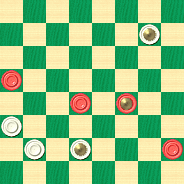The Checker Maven
Jump to navigationAn Historical Game

In today's entry in our Checker School series, drawn from Ben Boland's celebrated Famous Positions in the Game of Checkers, Mr. Boland is unusually laconic and we had to spend a few minutes divining the reason he titled the study below "An Historical Game." You'll understand it better after you try the problem and then view the solution and notes.
BLACK

WHITE
Black Plays; White Draws
W:WK8,21,25,K26:B13,18,K19,28.
Forces are even (Black is about to get a second king), but in checkers we know that's only half the story. Black has superior mobility and that often means victory. It looks like White is going to have an historic struggle here just to pull out a draw.
Can you make personal history by solving the problem, or will you just be history? It's not something to become "historical" over; give it your best try and then click on Read More to see the solution and all the trimmings.![]()
Solution
Sample game and lettered notes are from Mr. Boland's book; numbered notes are by the editor, using the KingsRow computer engine.
BLACK

WHITE
Black Plays; White Draws
W:WK8,21,25,K26:B13,18,K19,28.
For solution see Game at H.
Game: 11-15, 22-18, 15-22, 25-18, 8-11, 29-25, 4-8, 25-22, 12-16, 24-19---1, 16-20, 28-24---A, 8-12---B, 32-28, 10-15, 19-10, 7-14, 30-25, 9-13---C, 18-9, 5-14, 22-18, 6-9, 18-15, 11-18, 26-22, 1-5---D, 22-15, 14-18, 23-14, 9-18, 31-26---2, 3-7, 24-19, 2-6, 26-22, 5-9, 28-24, 7-10, 15-11, 9-14, 22-15, 14-18, 11-7, 12-16, 19-12, 10-28, 7-2, 6-10---E, 2-7, 10-14---F, 7-11, 28-32, 11-15, 32-23, 15-22, 23-19, 12-8, 20-24, 22-26, 14-18, 8-3, 24-28, 3-8---G, 28-32---H, 8-11, 32-28, 26-30---I,4, 28-24, 30-26, 24-27, 26-22---J, 19-15, 11-7---5, 18-23, 7-2, etc. Drawn---6.
A---To here by Pedro Ruiz Montero in Montero's "Libro del Juego de las Damas," published in 1590, one of the earliest works on the game.
B---By Joshua Sturges, 1800; improving Montero's 10-14.
C---By John Drummond, 1851; improving Sturges' 11-16.
D---By Charles Hefter, 1880; improving Drummond's 3-7.
E---By William Taylor, 1890; improving Hefter's 6-9---3
F---By Asa J. Richardson, 1900, improving Taylor's 10-15---3.
G---By Alfred Jordan, 1909, correcting Richardson's 3-7.
H---By "Free Lance," 1924, improving Jordan's 19-15---3.
I---By Joseph H. Scott, 1924, correcting 'Tree Lance's" 11-7.
J---By James A. Finn, 1924, correcting Scott's 11-16.
1---Somewhat inferior to 24-20---Ed.
2---It's interesting that the computer took some little while to find this line---Ed.
3---The difference in proposed moves is negligible---Ed.
4---We find it even more interesting that 26-31 loses---Ed.
5---11-8 loses---Ed.
6---We'll guess that this one wouldn't be so easy to find in over the board play---Ed.
The foregoing was compiled by Frank McLardy in the "City News," Manchester, England. And later in the "American Checker Monthly," 1934. It was also reviewed by P. H. Ketchum in the Dec. A. C. M. Page 313, 1924. Also see "Master Play," Var. 8IK and "Duffy's Single Comer," Var. 53.
In the "Weekly Times" (Melbourne, Aus.), where the article was reproduced, July 16, 1938, Mr. A. S. Clemens asks: "How can Black Win this line (at A) which is considered to be an established loss for White, i. e.: 19-15, 10-19, 23-16, 6-10, 26-23 (supposed to lose), 8-12, 30-26, etc?"
The last move, 30-26, is Mr. Clemens' proposed improvement of the textbook, 23-19, Black Wins. "It makes a critical and instructive study," says "Whilter" Draughts Editor of the "Weekly Times."
Editor's Note: The game is not "historical" in that it was a memorable game played in the past by master players. Rather, the game is historical in that it has an extensive history of commentary, correction, and continuous improvement. In an almost Talmudic-like process, refinements were made literally over the course of centuries. Checkers, far from being "dead," seems forever fresh.
You can email the Webmaster with comments on this article.
